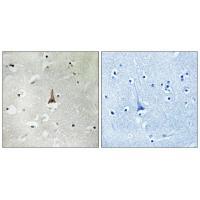
| WB | 咨询技术 | Human,Mouse,Rat |
| IF | 咨询技术 | Human,Mouse,Rat |
| IHC | 1/50-1/100 | Human,Mouse,Rat |
| ICC | 技术咨询 | Human,Mouse,Rat |
| FCM | 咨询技术 | Human,Mouse,Rat |
| Elisa | 咨询技术 | Human,Mouse,Rat |
| Aliases | Low-density lipoprotein receptor-related protein 10; |
| Entrez GeneID | 26020; |
| WB Predicted band size | 76kDa |
| Host/Isotype | Rabbit IgG |
| Antibody Type | Primary antibody |
| Storage | Store at 4°C short term. Aliquot and store at -20°C long term. Avoid freeze/thaw cycles. |
| Species Reactivity | Human,Mouse |
| Immunogen | Synthesized peptide derived from internal of human LRP10. |
| Formulation | Purified antibody in PBS with 0.05% sodium azide. |
+ +
以下是关于LRP1抗体的3篇参考文献及其摘要概括:
---
1. **文献名称**: *Endothelial LRP1 regulates amyloid-β clearance and blood-brain barrier integrity in Alzheimer’s disease*
**作者**: Storck, S. E., et al. (2016)
**摘要**: 该研究使用LRP1特异性抗体阻断其功能,发现LRP1在血脑屏障中介导Aβ肽的清除。抗体抑制LRP1后导致小鼠脑内Aβ沉积增加,认知功能下降,证实LRP1在阿尔茨海默病病理中的关键作用。
2. **文献名称**: *LRP1 regulates migration and invasion of breast cancer cells through interaction with uPAR*
**作者**: Mantuano, E., et al. (2008)
**摘要**: 研究通过LRP1抗体阻断实验,揭示LRP1与尿激酶型纤溶酶原激活物受体(uPAR)的相互作用促进乳腺癌细胞迁移和侵袭。抗体抑制LRP1后显著降低肿瘤细胞的转移能力。
3. **文献名称**: *LRP1 modulates TGF-β signaling in vascular smooth muscle cells*
**作者**: Gorovoy, M., et al. (2010)
**摘要**: 利用LRP1抗体检测其在血管平滑肌细胞的表达,发现LRP1通过调节TGF-β信号通路影响血管重塑。抗体阻断实验表明LRP1缺失导致炎症反应加剧和纤维化减少。
---
以上文献展示了LRP1抗体在神经退行性疾病、癌症转移及血管病理机制研究中的应用。如需具体文献链接或补充更多研究,可进一步说明。
LRP1 (Low-Density Lipoprotein Receptor-Related Protein 1) is a multifunctional transmembrane receptor belonging to the LDL receptor family. It plays critical roles in diverse physiological processes, including endocytosis, cell signaling, lipid metabolism, and clearance of extracellular proteins. LRP1 consists of a 515-kDa α-chain and an 85-kDa β-chain, forming a non-covalent heterodimer. The α-chain contains ligand-binding domains, while the β-chain mediates intracellular signaling through interactions with adaptor proteins. LRP1 interacts with over 40 ligands, such as apolipoprotein E, α2-macroglobulin, and amyloid-β, implicating it in neurodegenerative diseases, atherosclerosis, and cancer metastasis.
LRP1 antibodies are essential tools for studying its expression, localization, and function. They are widely used in techniques like Western blotting, immunohistochemistry, and flow cytometry to detect LRP1 in tissues or cultured cells. Specific antibodies targeting distinct domains (e.g., extracellular α-chain or cytoplasmic β-chain) enable researchers to investigate ligand-receptor interactions or downstream signaling pathways. Some antibodies are designed to block LRP1 activity, facilitating functional studies in disease models. Commercially available LRP1 antibodies vary in host species, clonality (monoclonal/polyoclonal), and epitope specificity, requiring validation for cross-reactivity across species (human, mouse, rat) and application-specific performance. Recent research highlights LRP1's therapeutic potential, driving demand for high-specificity antibodies to explore its role in neuroprotection, tumor suppression, and metabolic regulation.
×